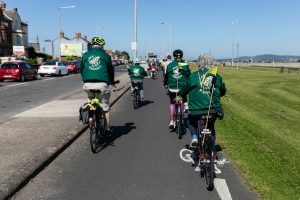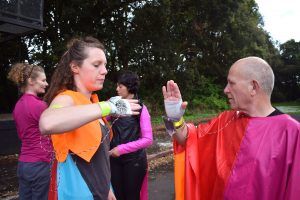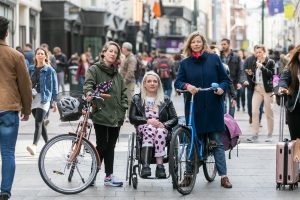I have lived in Dublin for nearly 20 years and I have always cycled here. It is my main mode of transport. Dublin City has seen great changes in that 20 years. The number of people cycling to work has increased dramatically and the city has been slow to keep pace with this change. The city can often feel very full with all modes of transport jostling for space in a city that has a tightly knit city core. Having travelled and spent time in The Netherlands and Denmark, countries that have managed to make cycling a key part of their identity in many ways, I have always been keen to encourage a vision of Dublin as a cycle-able city.
In 2019 Dublin hosted the Velo-city International Cycling Conference, which takes place in a different city around the world every year. The conference puts a spotlight on the subject of cycling in the city where it is hosted. This was an important opportunity to consider what kind of city we want in the future and to draw attention to best practice internationally.
I saw this platform as an opportunity to explore how art could play a role in drawing out stories and imaginaries for how Dublin could be designed and considered in the future through a programme called The Citizen Cycle. As an artist and a curator I have worked in collaborative and participative practice for over 10 years, and I saw this as an opportunity to bring citizens of Dublin into the conversation about the city and its infrastructure. I wanted to create the space for different voices to be heard and to allow participants to reconsider their position in the city and what they want from Dublin in the future.
In order to strengthen the engagement with participants and the city, I worked with partner organisations to realise each of the commissions. This allowed each project to have more support in finding and working with participants. It further helped to engage with the specific experience of each group and the existing networks of support for these groups in relation to cycling and participation in culture and city conversations.
The Citizen Cycle was made up of 3 commissioned collaborative artworks with communities of place and interest in Dublin. James Ó‘hAodha, whose work takes the form of interventions, performance/action and exchanges, and site-specific temporal encounters, partnered with Bealtaine (a festival for creativity as we age) to work with a group of older people who didn’t cycle to reclaim their space for cycling. James worked with a group of 8 people who are 65+, over 12 sessions, to develop a group identity for a bike gang now called The Bee Bandits. The work developed into a cycling performance, reclaiming space for older people in the city. The group explored the artistic potential of collective movement and visual identity, creating and testing group manoeuvres and developing a gang insignia. The Bee Bandits performed acts of pro-social behaviour to question the place of older people in Dublin and how the design of cities impacts who has access and can use the city. An iteration of the work was presented as part of The Bealtaine Festival in May 2019 and culminated in a participatory event for Velo-city in June 2019.

 Rhona Byrne, whose work looks at physical and social space, embodiment and interaction, worked with An Taisce’s Green-schools Initiative to engage children to think about their use of the city, the lack of cycling in their age group and to investigate how they would design the city to allow them to cycle and play more. Rhona worked with a group of 28 children from Springdale National School in Raheny, Dublin over a 5 month period to develop a model cycling city that was presented at St. Anne’s Park, the site for the main Velo-city Conference event beyond the conference venue.
Rhona Byrne, whose work looks at physical and social space, embodiment and interaction, worked with An Taisce’s Green-schools Initiative to engage children to think about their use of the city, the lack of cycling in their age group and to investigate how they would design the city to allow them to cycle and play more. Rhona worked with a group of 28 children from Springdale National School in Raheny, Dublin over a 5 month period to develop a model cycling city that was presented at St. Anne’s Park, the site for the main Velo-city Conference event beyond the conference venue.

Cliona Harmey, whose practice looks at the use of technology in our daily lives, worked with experienced cyclists from the Dublin Cycle Campaign to consider how cyclists communicate through movement in the city. The group worked with choreographer Muirne Bloomer, using hand gestures and signalling to communicate through e-textile gloves combined with wearable capes created with designer Marcella Cristina. Within the choreographed movement piece on bikes, the participants’ gestures triggered lights on their clothing, reflecting on cyclists as a community. This poetic technological and visual communication reinforces the sense of solidarity and affinity between cyclists. This colourful performance celebrated the joy of cycling and the comradery of sharing city streets with other cyclists.

Alongside the commissions a series of audio guides were developed called Listening to the City: three writers were commissioned to write and record audio guides for Dublin. Each looked at the city from a different perspective, free-wheeling through the city and weaving alternative routes and experiences of its streets. The audio-guides were available on the Velo-city app and to download from Soundcloud.
I worked with disability activist and journalist Louise Bruton, who introduced the listener to the Dublin she experiences as a wheelchair user, with some fun pop culture landmarks to enjoy along the way; academic and competitive cyclist Francis Halsall, looked at the systems of cycling in the city; and journalist and writer Louise Williams looked at women’s experience of cycling in the city, drawing on her own experience and the findings from the research group ‘women on wheels’, which looks at the barriers to women cycling in Dublin. Each writer has a particular view of the city, be that through the eyes of a sports cyclist who traverses the city and its environs to train, or a disability activist who experiences the city as a series of challenges and blocks, or a cyclist whose experience of Dublin is very much shaped and analysed through the lens of gender. Through the audio guides I wanted to generate awareness and insight into how people use the city differently and how the built environment impacted their experience both positively and negatively, creating opportunities for listeners to put themselves in another’s person’s shoes or saddle.

Finally, as part of the Citizen Cycle I wanted to create the space to build skills and competency in others to engage in city change through art and culture. The City Change Masterclass took place in May, working with 15 artists, activists, architects, producers and students to foster greater capacity in the arts community in Dublin to deliver projects in and for the city. Alongside Leticia Lozano, Ryan Swanson, Kate Stewart and Pete Vance, the master class shared some of the skills and knowledge that I have learned from my involvement through CPI. Through the masterclass I wanted to expand the notion of city change, bringing together a group of people who were interested in developing projects in the city with the aim to give them more tools to realise these projects to their full potential. Over the 3 days we invited different speakers to engage with the group: Ruairí O’Cuiv and Suzanne O’Connell from Dublin City Council spoke about their roles in developing public realm projects for Dublin, Roise Goan, independent producer (and now director of Arts Admin in London) spoke of her vast experience of realising projects in the city, and Louise Bruton and the children of Springdale National School brought the voice of some of the participants of the wider Citizen Cycle programme into the room. The masterclass was devised with the aim to bring different perspectives to bear on their proposals while also bringing the participants into contact with those who realise change in the city. Effecting any change through arts and culture in the city will not be done by one person and as such the masterclass aimed to foster greater levels of engagement with the city by more producers and artists to effect positive change for its citizens.

The Citizen Cycle was a challenging and rewarding programme to devise and deliver. There were many stakeholders in the process from artists, participants, partner organisations, PR and marketing support, Dublin City Council staff and the Velo-city organisers. It was quite a challenge to keep on top of all of the communications between these different groups. I worked with an assistant Julia Moustacchi who was invaluable in this regard, but ultimately the relationships were built up with me as the main ‘broker’ in the whole programme. This was a challenging role. Through the CPI development grant I had undertaken training in facilitation and stakeholder engagement, which was very useful in developing and maintaining these many relationships. I have also learned about the desire and importance of bringing artists together to share, support and exchange and this is something I will build into projects in the future.
Some of the main learning from the programme came from challenges while working with the wider team for the Velo-city events. It was challenging to create visibility for the programme with such a large scale event as this conference. I was working with people who had little experience of organising arts events and the very different needs in communicating a programme like The Citizen Cycle to the delegates. This was a new kind of cultural offer within the conference and there were teething problems and learning curves for all involved. I have learned to ask more in depth questions at all stages in the process of working with stakeholders and to presume nothing while pursuing visibility for the work, which is vital to creating impact and effecting change.
Working with the artists to realise the collaborative projects was very rewarding and gave me the opportunity to learn and grow from the experience. The artists were very open in their way of working and there was a willingness to engage with the wider focus of city change through the projects. I learned about the importance of the relationship between the artist and the partner organisations and individuals. Not all of the initial partnerships continued, and this highlighted the importance of being flexible in my approach and being open to amending plans in response to how the work developed and changed. Working closely with the artists to support their needs alongside that of their collaborators was key, maintaining conversation throughout the process to allow for change and mutability that inevitably occurs in process based collaborative work. Similarly, how I communicate the aims and objectives of the project was also important. I am a visual and verbal communicator and I lean heavily on face to face communication. I have learned that different styles of communication suit different learning types and I will bring this greater awareness to all of my engagements with artists and stakeholders in the future.
From a community and participant perspective the project was a resounding success. The older people who formed The Bee Bandits developed a greater sense of ownership of the city and an increased expectation that they should feel like the city is for them too. One participant noted that she hadn’t cycled for 50 years before the project and that she felt more comfortable cycling in the city as a result of her participation in the programme. Many had suggestions about improving Dublin as a city for cyclists and for older people. One participant said she found some of the public gestures the group performed continued to change the way she thought about taking up space in the city. During one public performance she had this encounter:
Member of the public: ‘Can’t you stand somewhere else?!’
Participant: ‘No.’

Equally, the children who worked with Rhona developed a greater awareness of their place, or lack thereof, in the city. The children noted that no one asks their opinion about the city. They think children don’t understand and they feel that they don’t matter. Many of the children felt unsafe in the city, with one child noting “When I walk through the city center I hold my mom’s hand, and it is my choice not hers to do this because I am too afraid to let go.” Through the project the children got to consider what they would like from a city and what a sustainable city might look like. They were given the space to expect more from a city and to be considered and provided for as equal users of the city. Furthermore the city model that was developed as part of the project will be showcased within the school and used in the future as a teaching tool to engage more of the children in conversations about city design and sustainability.

The participants who took part in the City Weave performance development were afforded time to think about their place in the city and how the city should and could be designed with them in mind. They could think of themselves as skilled users of the city, as a connected community. This participatory process led to interesting insights and a celebration of what it means to be a cyclist in Dublin.

Overall The Citizen Cycle gave voice to people’s experience of, and hopes and wishes for, Dublin city. The programme drew great attention from city stakeholders, communities and the media showcasing the value of citizen engagement and how art and culture can be used to generate creative and innovative conversations around the development of Dublin city.
While art may not have the power to change the city, it has the power to open the minds of its citizens, to realize that they should and can demand more from the city. The city should be for its people not just for the economy. We need liveable safe spaces, where people can move around freely and can be afforded the opportunity to be active. Cycling is a sustainable, healthy mode of transport and it should be open to all to avail of. The city should feel welcoming and comfortable for children, older people, those with disabilities and access needs. Until we reimagine Dublin city to make this a priority the city will remain a space for the few. The Citizen Cycle has taken a little step to bring this conversation to the fore.
